Autonomous car levels: the steps to your car driving itself explained
If car makers are to be believed, autonomous cars are the next big technology - here we explain the levels of autonomy on offer
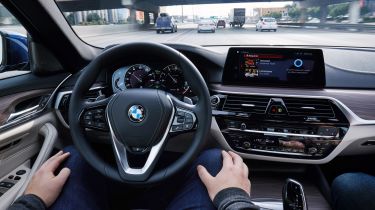
Car makers are forging ahead with increased autonomy for their new cars. Firms are embracing the idea of handing control of a vehicle over to the electronics on board, and believe that one day cars will be able to drive themselves to a pre-set destination without any driver input.
While manufacturers are rushing to develop this technology, many car buyers are yet to be convinced. However, it's easy to forget that all cars come with some sort of autonomy as standard. The electric starter motor eliminated the need for a hand crank on the front of cars, while engine electronics control the fuel/air mixture going into a combustion chamber, rather than a choke.
• Driverless cars: everything you need to know
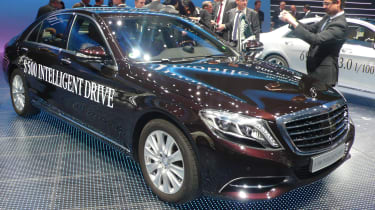
More significant is handy tech such as auto lights and wipers, while cruise control comes as standard on a number of new cars these days. The next level of cruise control is adaptive cruise, and this is one of the first steps towards true autonomous driving. Other tech such as lane keeping, traffic jam assist and road sign recognition are all part and parcel of autonomous car technology, while car makers believe that a fully autonomous car will be on sale within the next decade.
Of course, before this can happen, the technology needs to develop to a stage where it can be left to its own devices, without any input from occupants to control the vehicle. To help realise the autonomous car dream, a scale has been developed explaining are different levels of vehicle autonomy.
The US is at the forefront of much of this technology, with firms such as Google, Ford and Tesla pioneering the tech, while many other companies are developing their autonomous cars in the States. As a result, the American vehicle safety board the National Highway Traffic Safety Administration (NHTSA) has set out guidelines for autonomous driving, splitting the different stages of autonomy into five levels.
Car makers are now using these levels to describe the amount of autonomy offered by their assorted concepts, so here we explain what these five levels of autonomy mean...
Autonomous car levels explained
Level 0: No autonomy
Examples: Cars

It may seem obvious, but Level 0 autonomy covers all conventional cars, where the steering, throttle and brakes are all controlled by the driver. This also includes cars that feature electronic assistance devices such as forward collision warning, lane departure warning, parking sensors and blind spot monitoring, as these systems are passive and still require input from the driver to make a change in the car's direction of travel.
Level 0 also covers useful kit such as auto lights and wipers, and even indicators, as they all require input from the driver to turn them on and off. Even though this is an obvious category to be classified, it's the base level from which all autonomous technology in the following categories is measured from.
Level 1: Function-specific autonomy
Examples: Adaptive cruise control, ESP
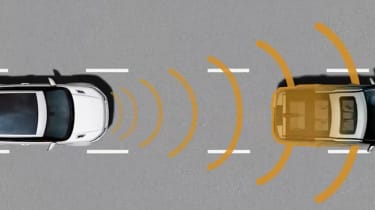
Level 1 autonomy covers most of the electronic driver aids that are available on new cars today. This includes adaptive cruise control, emergency brake assist and even electronic stability control. The classification of Level 1 autonomy is electronic assistance that still requires the driver to have main control of the vehicle, the key point being that control of either the steering or the throttle is still the job of the driver at all times.
In addition, the electronic assistance systems work independently from each other. This means that a car fitted with adaptive cruise control and active lane keeping has one set of sensors that adjusts the speed of the vehicle according to what's ahead, while a secondary set of sensors and electronics detect and steer the vehicle if the vehicle is leaving its lane. In essence, if the cruise control detects slow-moving traffic ahead of it, then the lane keeping cannot make the car change lanes in correspondence, because the different sets of sensors aren't working together.
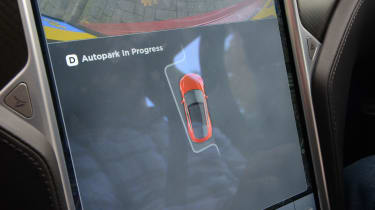
Self-parking is another form of Level 1 autonomy, because the driver operates the throttle while the car steers - it still requires the driver to stop and start to prevent a collision with the vehicle's surroundings.
Level 2: Combined function autonomy
Examples: Tesla Autopilot, Volvo Pilot Assist
Manufacturers have got as far as offering Level 2 autonomy on production cars. The NHTSA classifies Level 2 autonomy as technology that can take control of the vehicle in specific situations, but the driver is still expected to pay attention to the road and be able to take over control with little or no notice. The combined function of at least two pieces of technology (throttle and steering, for example) are responsible for keeping the vehicle moving, and they work together to maintain control.
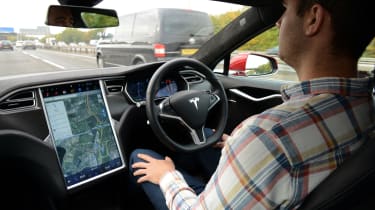
The leading pioneer of this technology is Tesla, with its Autopilot system. While the Autopilot name suggests the system can take complete control of the car, the reality is that the driver still needs to pay attention to the road, and Tesla ensures this happens by giving multiple warnings and confirmation buttons to press before autonomous control is handed over to the car.
BMW's latest Remote Control Parking is a form of Level 2 combined function autonomy. This technology debuted on the latest 7 Series, and allows the driver to automatically park the car from outside using the remote control keyfob. It allows the driver to start the car, put it in gear and move it into or out of a parking space from outside the car. The parking sensors prevent the car from colliding with obstacles, and the only control the driver has from outside the car is of the throttle.
While these systems are very advanced, they do have their shortcomings. They rely on a suite of advanced sensors that 'read' the road ahead, including road markings, speed limits and other vehicles, but they are only as good as the things that they can 'see'. Human eyes are better at defining lane markings if they have deteriorated, while most of these systems become ineffective in bad weather, such as snow or heavy rain, as their sensors become covered.
Level 3: Limited self-driving autonomy
Examples: Audi A7 piloted driving concept
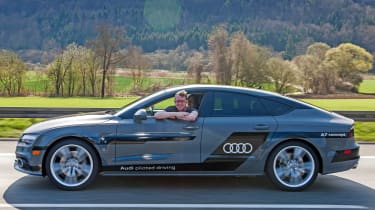
The next step that many car makers are embracing in prototype form is Level 3 autonomy. This hands most driving duties over to the car's electronics, but the driver will still need to take over in certain situations. However, this level of self-driving should give the driver enough advance warning that they need to take over that no critical situations should arise.
At Level 3, the electronics control the throttle, brakes and steering, and can perform lane changes and even negotiate stop-start traffic. Again, this type of autonomy currently works best on motorways due to the lack of pedestrians, parked cars and other smaller hazards, and manufacturers are concentrating on refining this technology before taking the next step of it being able to work on surface roads.
An early example of this is Audi's piloted driving concept, which we've tried in an A7 Sportback. This allows the driver to take their hands off the steering wheel for prolonged periods, and the car manages speed and steering for the whole time. Like Level 2 autonomy, the system has shortcomings in terms of bad weather, but the system will offer plenty of warning if a driving situation is beyond the abilities of the electronics.
Level 4: Fully self-driving autonomy
Examples: Google car, Volvo Drive Me
[[{"type":"media","view_mode":"content_wide_no_sidebar_second","fid":"179164","attributes":{"alt":"","class":"media-image","height":"280","typeof":"foaf:Image","width":"420"}}]]
The top level of autonomous driving is Level 4. The description the NHTSA has for fully self-driving autonomy is far briefer than it is for any other level, as the car's electronics perform all driving functions and monitors the road for the entire trip. Essentially all the occupants have to do is program a destination, and the autonomous vehicle will do the rest.
While a 'driver' is described in the NHTSA's brief, in some states in the US this is considered to be the person who has activated the autonomous technology, even if they're not physically in the car. So far no manufacturer has put an unmanned autonomous vehicle on the road, and all autonomous cars have the full set of driving controls for a person to take over driving at any time. In time, manufacturers believe that a fully autonomous vehicle will do away with a steering wheel and pedals completely, but that won't happen for a few years yet.
While moving through the levels is simple enough, the step to Level 4 autonomy is possibly the biggest of all, as the software will need to be capable of reading and interpreting its surroundings as quickly as the human brain, and it will need to be able to tell the difference between a variety of obstacles and situations.
Governments will need to ensure clear markings help autonomous cars negotiate all kinds of road, while the electronics will need to be able to operate in all weather conditions. Autonomous cars also need to be able to share road space with manually operated cars, which are likely to contribute a random factor that the electronics will need to be able to cope with. As a result, while manufacturers are singing the praises of fully autonomous cars, they're still a few years away from hitting showrooms.
Do you think level 4 self-driving cars will make it onto UK roads soon? Let us know in the comments section below...
Find a car with the experts



